Samsung SyncMaster 245T Review
Samsung SyncMaster 245T
Much sought after, but is the Samsung 245T the 24in display everyone should go and buy?
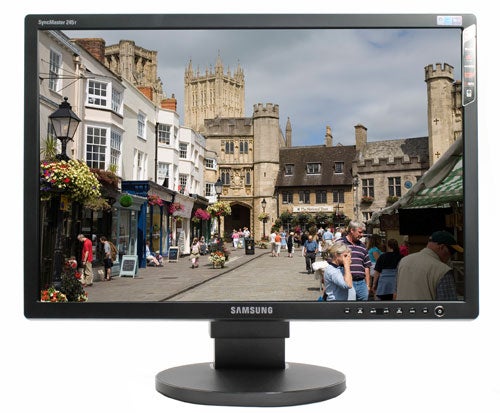
Verdict
Key Specifications
- Review Price: £610.99
There’s a school of thought that a good display is the single most important computing investment you can make. After all, what use is your new system sporting brand spanking new components like the Intel Core 2 Extreme QX9650 or nVidia’s 8800 GT, when you’re stuck with a dodgy old 19in 1,280 x 1,024 LCD? It’s hardly an ideal state of affairs and when you consider a good monitor will last you for years to come, there are plenty of compelling reasons to invest in something bigger and better. For many this has meant stepping up to a 1,680 x 1,050 22in display, often referred to as “the new 1,280” by virtue of the resolution striking a nice balance between viewable area and the processing power required to power it. 
This may be all well and good for many, but anyone in the know will tell you that what you really want is a 24in LCD. With a 1,920 x 1,200 native resolution you get appreciably more desktop real-estate, while the 1,920 pixel width means it’s the closest thing to 1,920 x 1,080 (1080p) ‘Full HD’ short of buying a 1080p capable TV. However, though the likes of the Iiyama ProLite B2403WS and Samsung SyncMaster 245B have bridged the gap somewhat in terms of price, the best 24in LCDs will set you back a fair pennyworth and today’s example is just such a specimen: the long awaited Samsung 245T.
This is the follow-up to the excellent SyncMaster 244T, which received an Editor’s Choice Award when we reviewed it back in March of last year but which has since been superceded by any number of releases, in particular BenQ’s FP241W but also the ‘High Colour’ versions of Dell’s 2407WFP. In the 245T, Samsung is attempting to redress the balance, paring a high quality S-PVA panel of its own making with a raft of connectivity that includes an HDCP enabled HDMI port. Thankfully, unlike Viewsonic’s VX2435wm, the inclusion of HDMI isn’t at the expense of the DVI port so there’s no need for complaint there.
Indeed, as far connectivity goes there’s nothing to complain about whatsoever. In addition to HDMI and DVI you get a good old fashioned D-SUB port, along with Component, S-Video, composite and four USB ports, with the USB and Component ports situated handily on the left outside edge where they can be easily accessed. There are no RCA audio inputs, however unlike the FP241W there is a 3.5mm audio output jack enabling one to pipe audio from the HDMI to speakers or a sound bar. This can be found on the back along with the rest of the connections and though it’s hardly a definitive advantage, those using games consoles may find it of particular benefit.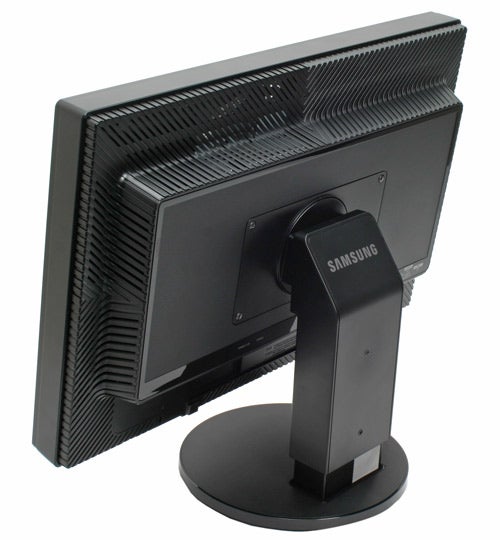
This touches upon one important aspect of the 245T: its versatility. It’s a fact it shares with the likes of the FP241W, providing the kind of connectivity that enables you to connect any number of devices at the same time. For example, with this arrangement you could connect a PS3 through the HDMI, Xbox 360 via D-SUB and Wii via the component outputs, making it a great space saving solution for those lacking exclusive access to the living room. Naturally enough there’s also scope for connecting standalone HD DVD and Blu-ray players, though you’ll need to get hold an HDMI switch such as AVTool’s AVT-5941 or the Belkin Pure AV HDMI 3-to-1.
Its versatility doesn’t end with the connectivity either, there’s also plenty of adjustability in the excellent stand design. There’s a generous amount of height adjustment, along with tilt control, pivot and rotation. Moreover, despite its relative size and weight the quality of the stand ensures the panel remains stable and easy to adjust whenever it’s required. Styling is also easy on the eye, being simple yet classy thanks to a nice slim bezel and an all black casing. As ever, there’s an elegance and simplicity to Samsung’s monitor design that’s always pleasing to see.
Upfront there’s the usual array of OSD control buttons, with a blue LED backlit power button and shortcut buttons for switching sources and activating picture-in-picture options. Among these is also a button for activating the ‘MPA’ (Motion Picture Acceleration) function, on which we’ll go into more detail later. As for the OSD itself, anyone who has owned a Samsung monitor will be familiar with the layout and on the whole it is nicely laid out and easy to navigate. First is the input menu, which obviously enables you to switch between inputs and rename them should you so desire. Here you can also find output information, enabling you to check if a device is outputting the desired resolution and so forth.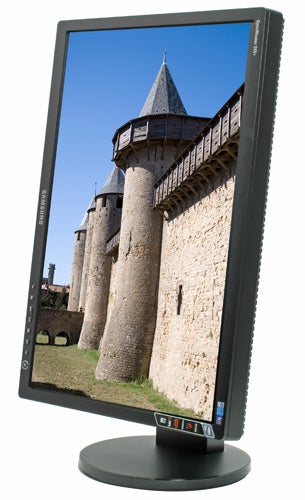
Next is the picture menu, which gives you access to the MagicBright presets as well as the contrast and brightness controls. Available presets tend to change based on the input in use, but during normal PC usage over DVI you can choose between Custom, Text, Internet, Game, Sports, Movie and Dynamic CR – the latter or which enables the dynamic backlight.
Another sub menu is Size, from which you can change the aspect ratio based on the resolution being outputted. So, if you’ve got a console outputting at 1080p you can set it to a 16:9 to prevent the display from scaling the image to its native 16:10 aspect ratio. This we can confirm is also a genuine 1:1 pixel map, with no cropping or cutting involved. This means you get proper 1080p without any scaling, though any resolutions below this will be scaled while maintaining the correct aspect ratio.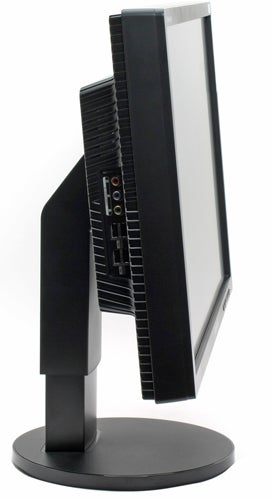
One step further down is the MagicColor Pro menu, providing a veritable smorgasbord of options for those who want control over every aspect of the colour settings. There’s a menu titled Color Innovation, which boosts colour to add vibrancy and contrast. There are several modes, including Custom, Mild and Brilliant and Demo, which splits the screen in half to show the difference. When enabled, Color Innovation seems to bring out blues and reds with greater impact and though the Brilliant mode was a little much, the Mild setting proved quite advantageous when watching video.
In addition there are several colour tone presets, including Normal, Cool 1, Cool 2, Warm 1 and Warm 2. We’re slightly perplexed as to why Samsung has chosen not to list colour temperature ratings here and the lack of an sRGB colour space preset is disappointing, however there’s plenty of scope for adjusting settings manually and much of this can be controlled using Samsung’s own software and display drivers. Rounding things off in the OSD is the picture-in-picture settings dialog, with general setup options bringing up the rear. Among the general settings options, it’s worth noting you can adjust the power button LED if the brightness annoys you in the dark.
Having teased with you all this info, it’s about time we get onto the important topic of image quality and performance. As already noted, the 245T unsurprisingly uses one of Samsung’s own S-PVA panels. Traditionally S-PVA panels are seen as a good compromise between the faster response times and reactivity of TN panels and the colour accuracy or IPS based monitors, which makes them uniquely versatile. They also have good viewing angles, with this example quoted at 178 degrees horizontally and vertically – a figure borne out by our experiences.
This particular panel sports a 1,000:1 contrast ratio, which is boosted to 1,500:1 when using the dynamic backlight. A grey-to-grey response time of 6ms is pretty solid and though the 300cd/m2 brightness may sound somewhat conservative by today’s standards, in reality it’s more than adequate. What certainly isn’t conservative is the claim about colour gamut coverage, with the 245T capable of reproducing 97 per cent of the NTSC colour space. This puts it in unique territory, with the ‘High Colour’ Dell 2407WFP-HC achieving only 92 per cent – though to say “only 92 per cent” is a tad unfair given the previous state of things.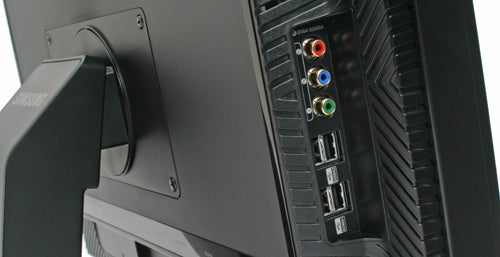
In any case, it’s an impressive asset and one that probably accounts for the notably higher price of the 245T when compared to both Dell’s offering and the likes of the BenQ FP241W and its derivatives. Another factor in this regard is the presence of Samsung’s Motion Picture Acceleration (MPA) technology, which is meant to help reduce the afterglow and ghosting that’s inherent in even the quickest LCD monitors. Indeed, it’s meant to do much the same thing as BenQ’s Black Frame Insertion method, though unlike BenQ’s solution Samsung’s technology increases the frame rate by using interpolated images whereas BenQ’s BFI method essentially tricks the eye by the insertion of black frames.
We’ll get onto to the performance of this feature later on but first let’s take a closer look at the general performance of the 245T, where it’s less a question of whether it is good but rather ”how” good it actually is. Getting started with the monitor it’s clear our sample has arrived with us properly calibrated, with nice balanced colour tones and none of the fluorescent reds that normally indicate a lack of calibration. As ever it’s impossible to say how indicative this is of retail versions, so it’s always worth researching other users experiences with models bought at retail.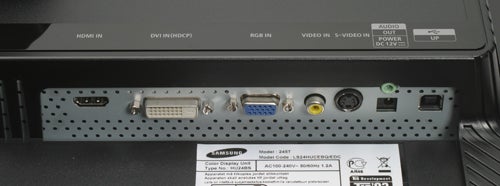
While performing everyday tasks the purity and vibrancy of the colours is quite apparent, as is the clean white level and sharpness of the text and before we even began testing it was clear the Samsung was going to be a good performer. DisplayMate was our first port of call, and on the whole the 245T put in a near flawless performance. Transitions in the Dark-Grey Scale and White-Level Saturation tests were spot on, with the 245T managing to produce even the most challenging shades to near perfection. This was also the case with the Colour Scales, with a perfect drop off at the bottom end of the scale and perfect transitions all the way along.
There was also no evidence of any banding on the intensity scale, which is an area where some Dell monitors reputedly struggle. However, the Screen Uniformity tests did reveal a slightly uneven backlight, with the left fifth of the panel proving to be lighter than the rest of screen. This was a source of some consternation given the otherwise superlative performance, though how much this will affect general use is difficult to gauge.
Next we embarked on some media testing, including high definition video and gaming. Again, it was hard not to be impressed. Watching The Bourne Identity and Superman Returns on HD DVD, the 245T definitely brings out the extra detail and fidelity of these full 1080p prints. Skin tones were natural while colours in general were vibrant, bringing proceedings to life with great clarity. Using the ‘Mild’ Color Innovation preset only improved matters, though as noted earlier the Brilliant mode proved a little too “brilliant” for its own good.
This also proved an opportune time to test the MPA feature we mentioned earlier: does it really reduce ghosting and afterglow? Without it enabled, the motion performance of the 245T is generally very good. Not quite as good admittedly as the fastest TN panels, but good enough that you’d be damned to tell the difference. As is typical where it really struggles is in slow panning shots, where some minor smearing and ghosting is evident. 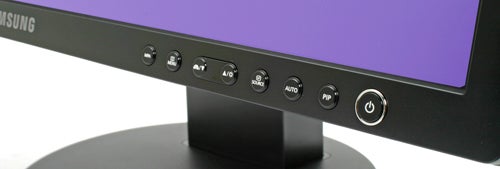
Regrettably, enabling the MPA mode does a little to improve matters, providing no discernible improvement and introducing a slight flicker that’s easily detectable in still scenes. Ultimately, this feature seems somewhat superfluous and we can’t imagine a lot of people finding it that useful so it’s just as well that video performance is still very good without it. Black levels are excellent, a point reinforced when playing games of all kinds where the strengths already outlined are continued. Some have suggested the 245T suffers from significant “input lag” and though we’re of the opinion that the issues surrounding input lag are distinctly overblown, if it does concern you then it’s worth investigating further.
Overall though, the 245T is in most respects an absolutely superb monitor that’s ideal for those looking for a versatile and high quality monitor. Its 97 per cent colour gamut coverage makes it excellent for image editing, while its video and gaming performance is also excellent. A tonne of connectivity only adds to the appeal, as does the genuine 1:1 pixel mapping from 1080p sources.
However, there are some reservations. Though the slightly uneven backlight is quite minor and very subtle, it’s a cause for some concern and the sensitive among you may notice it while watching video. More pressing though is the price, which compared to other 24in LCDs is quite prohibitive. At its cheapest it’ll cost slightly over £600, but we’ve only found one retailer who stocks it at this price. Otherwise, you can expect to pay well in excess of £700, which when you consider that lots of very capable alternatives are available for in the region of £450 to £550, makes it a rather expensive option.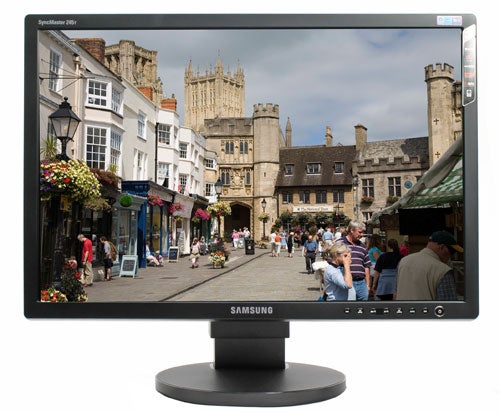
Ultimately, its main attraction is without a doubt the 97 per cent colour gamut that’s by far and away the best among its competitors. This makes it ideal for image editing, but it’s something of an extravagance if you’re more interested in its media capabilities. Thus, though we can recommend the 245T purely for its general excellence, it’s not for everyone and there are enough excellent and cheaper alternatives to prevent it from being a sure fire purchase.
”’Verdict”’
There’s little denying the quality of the Samsung 245T. It’s incredibly versatile with plenty of connectivity, adjustment and a simple and attractive design. Add in the 97 per cent colour gamut and 1:1 pixel mapping at 1080p and you have a recipe for greatness. However, the Motion Picture Acceleration mode is disappointing, while the slightly uneven backlight is a cause for concern. As such, at time of writing, the price needs to come down a fair amount before we can recommend it wholeheartedly.
Trusted Score
Score in detail
-
Image Quality 9
-
Value 6
Specs
| Screen Size (inches) (Inch) | 24 in |
| Aspect Ratio | 16:10 |
| Response Time (Millisecond) | 6 ms |
| Brightness (Lumen) | 300 Nitlm |
| Dot Pitch | 0.270 mm |
| Horizontal Viewing Angles | 178? |
| Vertical Viewing Angles | 178? |

